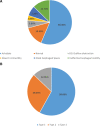Different patterns of esophageal motility disorders among patients with dysphagia and normal endoscopy: A 2-center experience
- PMID: 36197212
- PMCID: PMC9509117
- DOI: 10.1097/MD.0000000000030573
Different patterns of esophageal motility disorders among patients with dysphagia and normal endoscopy: A 2-center experience
Abstract
Esophageal motility disorders (EMDs) are the main etiology of nonobstructive dysphagia (NOD), but they are underestimated in Egypt. High-resolution manometry (HRM) with Chicago Classification version 3.0 (CC v3.0) is the current gold standard diagnostic modality to assess EMD in patients with NOD. In this HRM-based study, we aimed to classify EMD among Egyptian patients and explore the relationship between the severity of symptoms and the various groups of EMD. From January 2020 to January 2021, patients with dysphagia were subjected to diagnostic workup, which included symptom questionnaire for Eckardt score, esophagogastroduodenoscopy, barium esophagogram, and HRM. All patients were categorized based on the HRM results using CC version 3.0 after exclusion of those with obstructive esophageal lesions. Of 252 patients with dysphagia, 55 patients with NOD were analyzed according to CC version 3.0. Achalasia was diagnosed in 31 patients (56.4%) (type I: 18 [58.06%]; type II: 9 [29.03%], and type III: 4 [12.9%]), 3 patients (5.5%) with esophagogastric junction outflow obstruction, 2 patients (3.6%) with absent contractility, 4 patients (7.3%) with distal esophageal spasm, 7 patients (12.7%) with ineffective esophageal motility, and 8 patients (14.5%) with normal manometry. Patients with achalasia experienced significantly high regurgitation (96.8% vs 70.8%; P = .016) compared with those without achalasia. Achalasia was the most common EMD in Egyptian patients with NOD. Eckardt score was higher in patients with outflow obstruction and major motor disorder, but it could not differentiate different categories of CC of EMD. HRM is effective in characterization of EMD.
Copyright © 2022 the Author(s). Published by Wolters Kluwer Health, Inc.
Conflict of interest statement
The authors have no funding and conflicts of interest to disclose.
Figures



Similar articles
-
Etiologies and clinical characteristics of non-obstructive dysphagia in a Taiwanese population: A prospective study based on high-resolution impedance manometry.J Formos Med Assoc. 2019 Nov;118(11):1528-1536. doi: 10.1016/j.jfma.2018.12.019. Epub 2019 Jan 8. J Formos Med Assoc. 2019. PMID: 30635154
-
Esophageal Motility Disorders: Diagnosis and Treatment Strategies.Digestion. 2024;105(1):11-17. doi: 10.1159/000533347. Epub 2023 Aug 25. Digestion. 2024. PMID: 37634495 Review.
-
Esophageal Motility Disorders: A Concise Review on Classification, Diagnosis, and Management.Mayo Clin Proc. 2025 Feb;100(2):332-339. doi: 10.1016/j.mayocp.2024.09.024. Mayo Clin Proc. 2025. PMID: 39909671 Review.
-
Esophageal Hypervigilance and Visceral Anxiety Are Contributors to Symptom Severity Among Patients Evaluated With High-Resolution Esophageal Manometry.Am J Gastroenterol. 2020 Mar;115(3):367-375. doi: 10.14309/ajg.0000000000000536. Am J Gastroenterol. 2020. PMID: 31990697 Free PMC article. Clinical Trial.
-
An indication-based analysis of the yield and findings of esophageal high-resolution manometry.Scand J Gastroenterol. 2025 Apr;60(4):368-374. doi: 10.1080/00365521.2025.2475083. Epub 2025 Mar 7. Scand J Gastroenterol. 2025. PMID: 40052859
Cited by
-
Association of esophageal motility disorder symptoms with Chicago classification versions 3.0 and 4.0 using high-resolution esophageal manometry: A single-center experience from Saudi Arabia.Saudi J Gastroenterol. 2024 Mar 1;30(2):96-102. doi: 10.4103/sjg.sjg_243_23. Epub 2023 Aug 8. Saudi J Gastroenterol. 2024. PMID: 37602637 Free PMC article.
References
-
- [1]Tanaka Y Ihara E Nakamura K et al. . Clinical characteristics associated with esophageal motility function. J Gastroenterol Hepatol. 2016;31:1133–40. - PubMed
-
- [2]Zerbib F Omari T. Oesophageal dysphagia: manifestations and diagnosis. Nat Rev Gastroenterol Hepatol. 2015;12:322–31. - PubMed
-
- [4]Gyawali CP Patel A. Esophageal motor function: technical aspects of manometry. Gastrointest Endosc Clin N Am. 2014;24:527–43. - PubMed
MeSH terms
Substances
LinkOut - more resources
Full Text Sources
Medical

